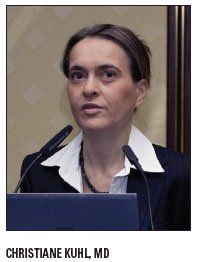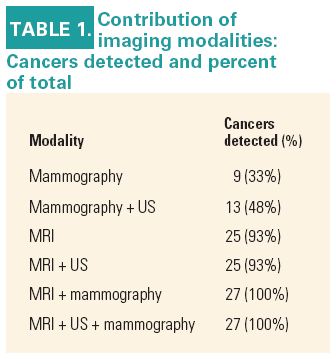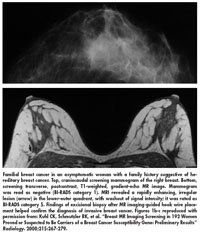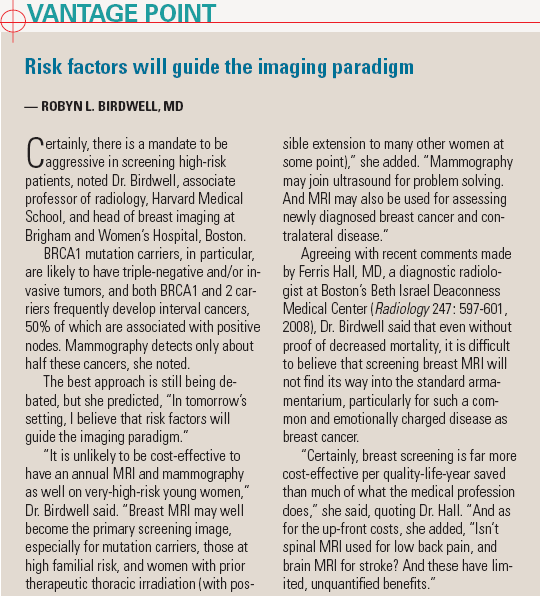Is breast MRI primed for widespread use as a high-risk screening tool?
There is no doubt women at high risk for breast cancer need to be screened more aggressively than the general population. Thanks to extensive research-not to mention a nod from the American Cancer Society as a screening tool-MRI has leapt ahead of other imaging modalities as the preferred modality in a high-risk population.
ABSTRACT: ASCO presenters trumpet MRI’s superior breast cancer detection, especially in women with genetic mutations, while asking how to secure the modality’s place in the breast imaging armamentarium.

CHICAGO-There is no doubt women at high risk for breast cancer need to be screened more aggressively than the general population. Thanks to extensive research-not to mention a nod from the American Cancer Society as a screening tool-MRI has leapt ahead of other imaging modalities as the preferred modality in a high-risk population.
But whether MRI offers the final word in women at a genetic risk for breast cancer is still a matter for debate. At ASCO 2008, a session on screening high-risk women offered insights into MRI’s strengths, while also pointing out some of it weaknesses.
The ‘must have’ modality
Christiane Kuhl, MD, of the University of Bonn, Germany, has been one of the pioneers in breast MRI for high-risk screening. At ASCO, Dr. Kuhl reported the findings from the EVA trial, a 3-year prospective multi-institutional observational cohort study that looked at the relative contributions of different imaging modalities in detecting cancers (abstract 1500).
The trial enrolled 687 women, aged 25 to 70, with elevated risk based on BRCA1/2 mutation (12%), strong family history (62%), or personal history of breast cancer plus familial risk (26%).
The women underwent annual screening, starting at age 30, with two-view full-field digital mammography, physician-performed high-frequency ultrasound, and dynamic contrast-enhanced subtracted MRI.
Among 1,679 complete screening rounds, 27 breast cancers were detected, for an overall incidence of 16 per 1,000 women. Mean age at diagnosis was 43. These were mostly minimal and node-negative cancers (including 20% DCIS), and no interval cancers were diagnosed during the program.
“Mammography alone is not suitable for screening women at increased familial risk. Only MRI

offers adequate sensitivity and should constitute the basis of any screening protocol. It is the ‘must have’ imaging modality,” Dr. Kuhl said.
MRI was, by far, the most valuable modality in detecting cancer in these high-risk women, Dr. Kuhl reported (see Table 1). The addition of mammography or ultrasound did not increase the diagnostic accuracy of MRI.
“The real question is not whether we need more than mammography, but whether we need more than MRI,” Dr. Kuhl said. “We believe that MRI should be the new reference and the basis of screening young high-risk women. And we should reappraise the use of mammography, especially in BRCA1 mutation carriers.”
Older women
In another ASCO presentation, Johnny Bernard, Jr., MD, pointed out that MRI screening may also be optimal in older women. In a study by Dr. Bernard and colleagues at the Mayo Clinic, Jacksonville, Florida, MRI detected contralateral cancer in 5.7% of women aged 70 and older, with 100% sensitivity and 87% specificity (abstract 500).
Mayo researchers reviewed the cases of 159 breast cancer patients aged 70 and older and found that MR imaging detected contralateral abnormalities in 65 subjects (41%).
Cancer was ultimately confirmed in 9 (5.7%), including 5 cases of invasive ductal carcinoma and 4 cases of DCIS. All were mammographically occult, Dr. Bernard reported.
Bilateral breast imaging has been found to detect contralateral cancer in 3.2% of women aged 40 to 65, but this is the first study to evaluate its benefit in older women, he added.
“We feel that older women should not be discriminated against when considering the use of breast MRI, and we consider contralateral MRI the standard of care for older breast cancer patients,” Dr. Bernard said.
Staggered imaging

Finally, research out of the University of Pennsylvania in Philadelphia indicated that a staggered imaging protocol that rotates MRI with mammography was particularly useful in BRCA1/2 mutation carriers.
Medical student Payal Shah reported findings in 93 carriers, aged 35 to 62, who received an entry mammogram and breast MRI 3 months apart, then mammography and MRI yearly thereafter (though not always simultaneously) between 2003 and 2005 (abstract 11000).
At a median follow-up of 3 years (after 283 MRIs and 282 mammograms), breast cancer was detected in 11 patients, or 12% of the cohort, and all were detectable on MRI, Ms. Shah said.
The senior author on this study was Susan Domchek, MD, an associate professor of medicine.
All cancers occurred in BRCA1 carriers, and included 9 invasive ductal carcinomas stages I to III, and 3 DCIS grade 3 lesions.
Nine of the 11 cancers occurred in women a median of 4 years post-oophorectomy (87% of the cohort had undergone this procedure prophylactically).
Of 11 cases, 6 were detected by imaging, and concurrent mammography was positive in just 2 of 4 cases. Three were detected by mammography, and concurrent MRI was positive in two of the three.
Of the 11 cases, 8 were detected within 1 year of a negative mammogram, and 2 were interval cancers picked up on self-breast examination and confirmed by imaging.
